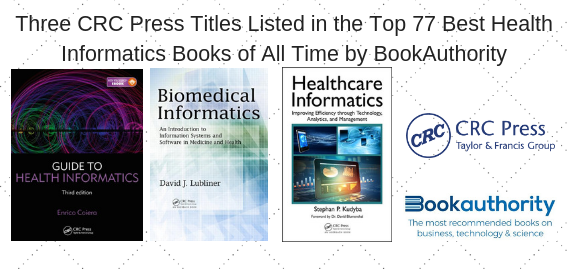Three CRC Press titles listed in the Top 77 Best Health Informatics Books of All Time by BookAuthority

CRC Press is pleased to announce that three of our titles have been listed in the “77 Best Health Informatics Books of All Time” by BookAuthority. BookAuthority curates the books recommended by the world’s most successful CEOs, business leaders and experts.
Please view these three titles, ranked four, seven, and twenty-one respectfully:
 Guide to Health Informatics, Third Edition
Guide to Health Informatics, Third Edition
By Enrico Coiera
March 2015
This essential text provides a readable yet sophisticated overview of the basic concepts of information technologies as they apply in healthcare. Spanning areas as diverse as the electronic medical record, searching, protocols, and communications as well as the Internet, Enrico Coiera has succeeded in making this vast and complex area accessible and understandable to the non-specialist, while providing everything that students of medical informatics need to know to accompany their course.
Fully revised, the third edition of Guide to Health Informatics remains essential reading for all health science undergraduates, clinical health professionals, and health service managers who need to appreciate and understand the role of informatics and its associated technologies for optimal practice and service delivery.
 Biomedical Informatics: An Introduction to Information Systems and Software in Medicine and Health
Biomedical Informatics: An Introduction to Information Systems and Software in Medicine and Health
by David J. Lubliner
November 2015
Medical informatics lies at the intersection of computer science and medicine and understanding critical aspects of both fields provides for more proficient practitioners. Biomedical Informatics: An Introduction to Information Systems and Software in Medicine and Health supplies a cohesive narrative of the multidisciplinary concepts linking the field.
This complete medical informatics textbook begins by reviewing the IT aspects of informatics, including systems architecture, electronic health records, interoperability, privacy and security, cloud computing, mobile healthcare, imaging, data capture, and design issues. Next, the text provides case studies that demonstrate the roll out of electronic health records (EHRs) in hospitals. The third section incorporates four anatomy and physiology lectures that focus on the physiological basis behind data captured in EHRs. Examples include detailed descriptions of the heart and electrical systems, lungs and alveoli, and oxygen exchange.
The book includes a primer on the theoretical concepts that underpin the science behind medical informatics, including an Anatomy & Physiology Essentials guide. It also contains a tutorial on application development to help students understand the tools for improving user interfaces for EHRs on mobile platforms.
The author uses a student-friendly organizational structure that supplies students with a clear demarcation between essential and optional material. The text supplies clear delineation between Level I, concepts every biomedical informatics professional needs to master; Level II, applied concepts and examples; and Level III, advanced topics. This format allows undergraduate and graduate instructors and professionals in the field to focus quickly on the essential topics, and if interested, delve into Level III advanced topics.
The book includes links to documents and standards sources so students can explore each idea described in more detail. Instructor’s manual, solutions manual, videos, figure slides, and lecture slides are available upon qualified course adoption.
 Healthcare Informatics: Improving Efficiency through Technology, Analytics, and Management
Healthcare Informatics: Improving Efficiency through Technology, Analytics, and Management
by Stephan P. Kudyba
April 2016
Healthcare Informatics: Improving Efficiency through Technology, Analytics, and Management supplies an understanding of the different types of healthcare service providers, corresponding information technologies, analytic methods, and data issues that play a vital role in transforming the healthcare industry. All of these elements are reshaping the various activities such as workflow and processes of hospitals, healthcare systems, ACOs, and patient analytics, including hot spotting, risk stratification, and treatment effectiveness.
A follow-up to Healthcare Informatics: Improving Efficiency and Productivity, this latest book includes new content that examines the evolution of Big Data and how it is revolutionizing the healthcare industry. It presents strategies for achieving national goals for the meaningful use of health information technology and includes sound project management principles and case illustrations for technology roll-out, such as Computer Physician Order Entry (CPOE) for optimal utilization.
The book describes how to enhance process efficiency by linking technologies, data, and analytics with strategic initiatives to achieve success. It explains how to leverage data resources with analytics to enhance decision support for care providers through in-depth descriptions of the array of analytic methods that are used to create actionable information, including Business Intelligence, Six Sigma, Data, and Text Mining.
Guide to Health Informatics is available via
https://www.crcpress.com/9781444170498
Biomedical Informatics is available via
https://www.crcpress.com/9781466596207
Healthcare Informatics is available via
https://www.crcpress.com/9781498746359
To request a review copy please visit:
http://pages.email.taylorandfrancis.com/review-copy-request
For press enquiries, please contact:
Samantha Holt
samantha.holt@informa.com

 China
China